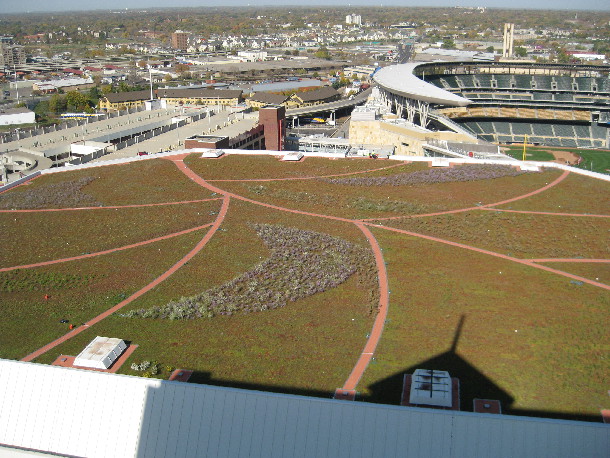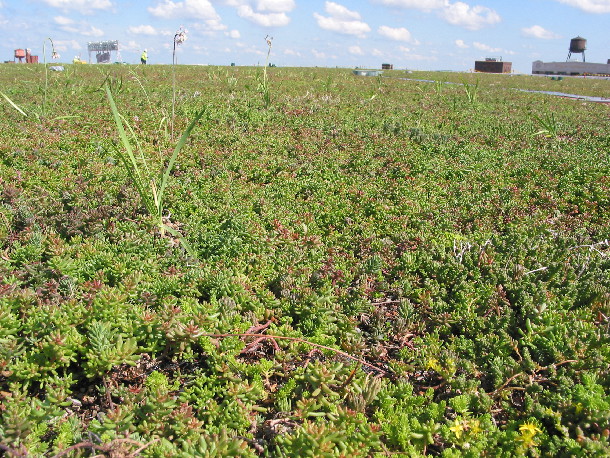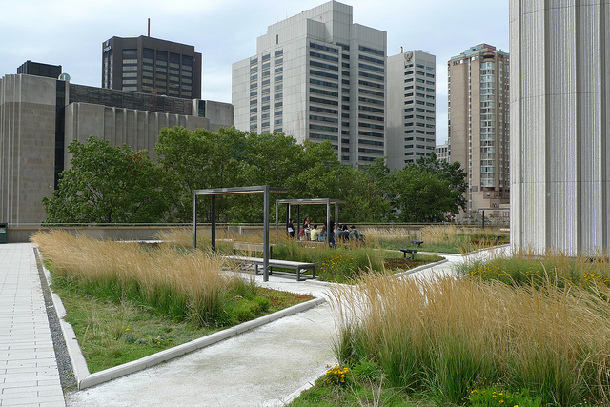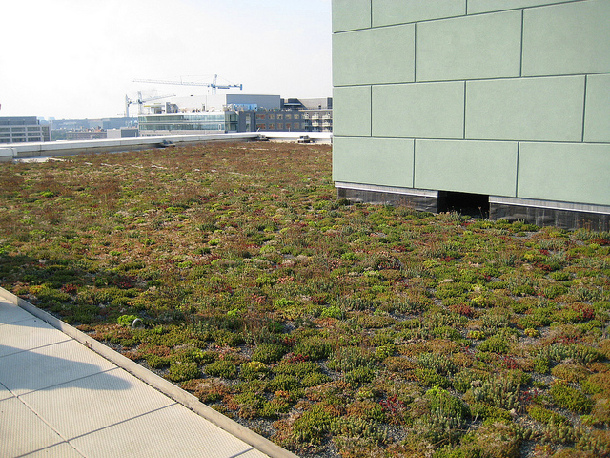The Costs and Benefits of Green Roofs

Target Center Arena Green Roof, Minneapolis, MN: Example of a large scale green roof providing significant stormwater benefits even in urban area dominated by impervious surfaces. The Target Center Arena Green Roof retains and evapotranspires more than a million gallons of water per year. Image Kestrel Design Group ©
While green roofs have been used for the past 30-40 years in Europe, the spread of green roof technology in North America is much more recent. Need for low impact stormwater management techniques is one of the biggest drivers for green roof technology in North America.
A green roof (also called a living roof, or vegetated roof) typically consists of vegetation and a growing medium, over a high quality water proofing and root repellent system, a drainage system, and a filter layer. Green roofs can serve several valuable purposes, and replacing typically impervious surfaces with a pervious vegetated surface that can abstract and filter rain water is one of those. Depending on the site goals, the structural capacity of the roof, and the budget, the depth of the green roof growing medium can vary from a few inches to more than a foot. Vegetation can range from succulent plants like sedums, to native grassland plants, perennials, shrubs and trees, or even crops like vegetables.
So how do green roofs fit into the overall low impact development (LID) stormwater tool kit? Lets start by looking at costs and benefits.

Target Center Arena Green Roof, Minneapolis, MN: Example of a large scale green roof providing significant stormwater benefits even in urban area dominated by impervious surfaces. The Target Center Arena Green Roof retains and evapotranspires more than a million gallons of water per year. Image Kestrel Design Group ©
Costs for green roofs can range from $15 per square foot on up, depending on many factors, such as growing medium, depth, and green roof size. First gallon cost is the capital cost to install enough of a stormwater BMP to treat 1 gallon of runoff, and it's how we often discuss the cost of stormwater management tools. We estimate that, at costs per square foot from $15 per square foot (929 cm2) and up, the first gallon costs (i.e. cost for first 3.785 liters of water) for extensive green roofs (defined as having a growing medium depth 6 inches/15 cm or less) range from $28-$35.
The first gallon cost of green roofs is significantly higher than that of most other urban stormwater best management practices (BMPs). In comparison, we estimate that cisterns cost about $2 to $5 per first gallon treated, and urban trees about $6 to $8 per first gallon treated. BUT, despite their high capital costs and high cost per gallon treated, a look at life cycle costs and benefits shows that green roofs still make economic sense on many urban sites. Like most other stormwater BMPs, green roof technology can offer many other benefits in addition to stormwater management, including:
- Extends waterproofing membrane lifespan 2-3 times
- Provides stormwater volume, rate, and quality benefits.
- Cools any rain that does run off the roof.
- Lowers energy costs for heating and cooling building
- Improves urban air quality-reduces dust and smog levels
- Lessens urban heat island effect
- Provides sound insulation
- Improves aesthetics which also produces psychological and economic benefits
- Potential for urban agriculture/local food production and/or public open space where at grade space is not available
- Adds wildlife habitat
When all the cost and all the benefits over the lifespan of a roofing membrane are added together, and compared to those of a traditional roofing membrane, the total life cycle cost of a green roof is often actually lower than that of a traditional roof, even though the green roof costs a lot more up front.
So, what are some of places and situations where green roofs make the most sense? Some examples include:
- For building owners who will own the building long-term, long enough to capitalize on the extended roofing membrane lifespan
- Where at grade space is desired but not available at grade for example, for stormwater management, horticultural therapy, urban agriculture, or hospital healing gardens.
- Where a green view is desired instead of a view of a traditional impervious roof.
The magnitude of stormwater benefits provided by green roofs varies depending on many factors, such as soil composition and substrates, plant species and diversity, and storm duration and intensity, as well as climatic factors, including sun, wind, and even season of the year. They are most beneficial for high intensity, short duration storms, vs. long duration storm events. They are therefore even more effective for stormwater management here in the Midwest of the United States, where we at the Kestrel Design Group Design Group design most of our green roofs, than in European climates where it rains longer and more frequently and the green roofs do not dry out as much in between rain events.

Flickr credit: bricoleurbanism
To further increase stormwater benefits, green roofs can also be combined with other stormwater BMPs to reduce site runoff even more:
Rain that does leave the green roof can be harvested and re-used, for example, to irrigate the green roof (and cool the building below!), to irrigate at grade landscapes, or for indoor water use. Harvesting rain from green roofs for later re-use to water the green roof makes the most sense in climates where green roofs dry out so much between storm events that irrigation is needed to keep them green, i.e. in many parts of the Midwestern and Western U.S. Benefits of irrigating a green roof with harvested stormwater are magnified even more where building cooling is desired underneath the green roof, so hot, dry climates, with short duration high intensity storms can especially benefit greatly from green roofs irrigated with harvested rainwater, as they will gain the greatest stormwater AND cooling benefits.
According to Mankiewicz and McDonnell (2006), "a hundred gallons of water is equivalent to about a centimeter of water over 400 square feet. The evaporation of such a quantity of water would be the equivalent of about 18 tons of air conditioning. By way of comparison, a 400 square foot room usually calls for about a one ton air conditioning unit, so a hundred gallons of water could provide the equivalent cooling power of a ton of air conditioning to a 7,000 square foot roof" (emphasis added).
While there are associated costs, the benefits of green roofs are clear. I hope we continue to see more of them in our cities and towns.
Nathalie Shanstrom is a Sustainable Landscape Architect with the Kestrel Design Group.
References
Mankiewicz, P. and T. McDonnell. 2006. Sustainable Green Roof Design: Optimizing Water Budgets Through Wastes-Into-Resources Technologies In The Bronx. Conference Proceedings for Greening Rooftops For Sustainable Communities, Boston, MA.
For more detail on the stormwater benefits of green roofs, see:
Berghage, R., D. Beattie, A. Jarrett, C. Thurig, F. Razaei, AND T. O'Connor. 2009. Green Roofs for Stormwater Runoff Control. U.S. Environmental Protection Agency, Washington, D.C., EPA/600/R-09/026,
Carter, Timothy and C. Rhett Jackson. 2007. Vegetated roofs for stormwater management at multiple spatial scales. Landscape and Urban Planning. 80 (2007) 84–94
Compton, J. S., and T. H. Whitlow. 2006. A Zero Discharge Green Roof System and Species Selection to Optimize Evapotranspiration and Water Retention. Greening Rooftops for Sustainable Communities, Boston, MA, May 11-12, 2006.
Lundholm, J., MacIvor J.S., MacDougall, Z., Ranalli, M. 2010. Plant species and functional group combinations affect green roof ecosystem functions. PLoS ONE 5(3): e9677.
Peck, S., C. Callaghan, M. Kuhn. and B. Bass,. 1999. Greenbacks from Green Roofs: Forging a New Industry in Canada Status Report on Benefits, Barriers and Opportunities for Green Roof and Vertical Garden Technology Diffusion. Prepared for: Canada Mortgage and Housing Corporation March.
Wolf, Derek and Jeremy T. Lundholm, Water uptake in green roof microcosms: Effects of plant species and water availability, Ecological Engineering, Volume 33, Issue 2, 3 June 2008, Pages 179-186, ISSN 0925-8574, DOI: 10.1016/j.ecoleng.2008.02.008.
Simmons, M., B. Gardiner, S. Windhager, and J. Tinsley. 2008. Green roofs are not created equal: the hydrologic and thermal performance of six different extensive green roofs and reflective and non-reflective roofs in a sub-tropical climate. Urban Ecosystems. 11 (4) 339- 348. UR - http://dx.doi.org/10.1007/s11252-008-0069-4. DO - 10.1007/s11252-008-0069-4

